|
Flight Sergeant H Wiggins.
NZ 404562
Air Bomber
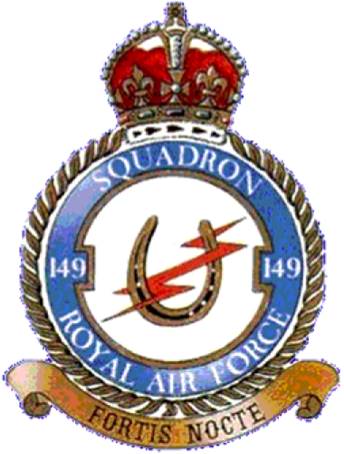
flying with
149 (East India) Squadron, RAF
(Deduced and expanded from the Operational Records Book entries).
The Squadron.
As war approached, No 149 (East India) Squadron, which had served briefly in World War I, was re-formed in 1937 at RAF Mildenhall as a night heavy bomber unit. It was initially equipped with the last RAF heavy bomber biplane, the Handley Page Heyford, but not for long. In early 1939 these were replaced with the new, geodetic structured Vickers ‘Wellingtons’. Designed by Barnes Wallis, of Dam Buster fame these were sturdy, reliable aircraft which could absorb a great amount of damage and still return home.
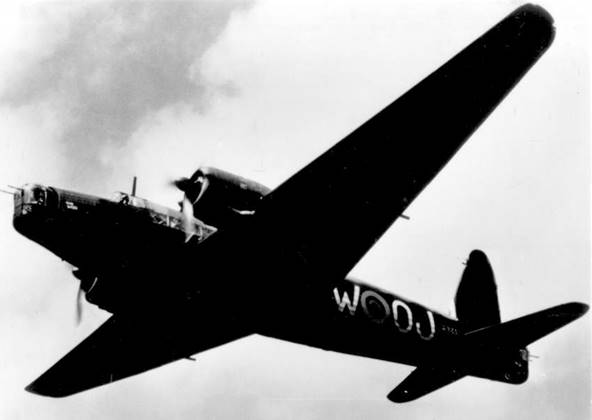
Wellington 1c of 149 Sqn – source unknown
Then along came the mighty Short’s Stirling Aircraft.
Various constraints had turned the original design into an aircraft which was badly behaved on the ground, very manoeuvrable at low and medium altitude, but sadly deficient at its operational ceiling of twelve to fifteen thousand feet.
Looking a bit like a bulldog, with exceptionally long main undercarriages, the Stirling was either loved or hated….or both depending on the latest flight. The aircraft served 149 Sqdn right up until its withdrawal from mainstream bombing in late 1944, due to unacceptable losses when employed in this role.
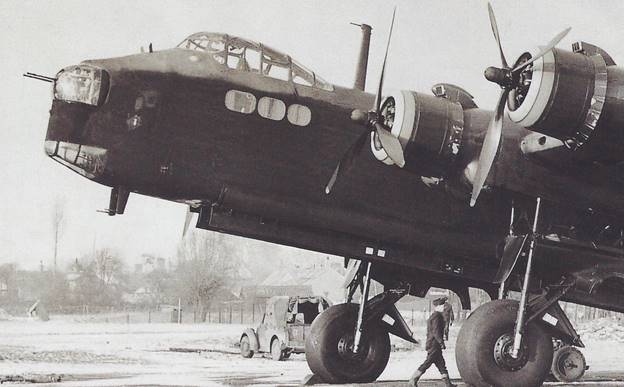
Short Stirling of 149 Sqn

The crew for the first trip were:
Flt Sgt G A Cozens Pilot
Sgt P Hodgkinson Flt Eng
P/O E G Redman Navigator
Sgt H Wiggins RNZAF Bomb Aimer
Sgt W J Williams Rear Gunner
Sgt L W Curtis Mid-upper Gunner
Flt Sgt R A Hodge RNZAF Wireless Op
Sgt Wiggins volunteered for RAF Aircrew. These men were always volunteers, never conscripted, and usually had visions of becoming a Pilot - but not all progressed to this position. It is as well to remember that a Bomber Crew was just that - a crew. Without any one of the crew, the rest were vulnerable and possibly unable to complete their mission. (He) actually filled a number of posts with his chosen crew, from Tail Gunner to Bomb Aimer, as required.
Posting to 149 – was on 17/2/43 from 75 Sqn.
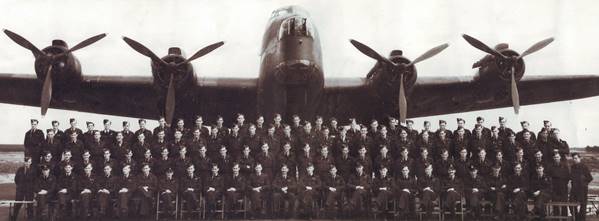
149 (East India) Squadron Aircrew in mid 1943
It is almost definite that the crew were in this photograph.
Operations.
1st Op. 23rd Mar ‘43 – Aircraft OJ-R, EF360. Took off at 19.02, landed at RAF Lakenheath at 00.26 Target - St Nazaire
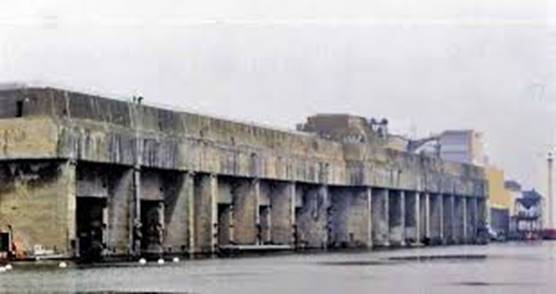
St Nazaire U-Boat Pens
Crew report: Little cloud but very hazy. Green and Red T.Is (Target Indicators) coincided with ETA (estimated time of arrival). Bombs dropped and a few small fires seen. Attack not so good as last one. (This is strange as this was the first trip for this crew with 149. It may have been made by a crew member from another crew).
War Diaries Comment: 357 Aircraft – 189 Lancasters, 99 Halifaxes, 63 Stirlings, 6 Mosquitoes. 1 Lancaster lost. 3 Group sent out a recall order to its Stirlings and only 8 carried on to bomb the target. Accurate marking led to a concentrated attack by 283 aircraft on the Port area of St Nazaire.
2nd Op. 4th Apr ‘43 –Aircraft OJ-H, BF477. Took off at 19.02, landed at RAF Lakenheath at 02.25 - Target - Keil
Crew report: Cloud tops 3/4000. One area glowing Red. Green T.I. went down beside (it) and after bombing, second stick of Green fell on same spot. Green T.I.s seen in bombsight. Glow visible 70 miles away. (slide 73)
War Diaries Comment: 577 Aircraft – 203 Lancasters, 168 Wellingtons, 116 Halifaxes, 90 Stirlings. Largest raid so far on Keil. Also the largest Non-1000 Bomber raid of the War, so far.5 Lancasters, 4 Halifaxes, 2 Stirlings and 1 Wellington lost – 2.1 % of the force. Pathfinders encountered thick cloud and strong winds over the target so that accurate marking became very difficult. It was reported that decoy fire sites may also have drawn off some of the bombing. Keil reported only a few bombs in the town with 11 buildings destroyed, 46 damaged and 26 people being killed. No commercial premises were hit; the only building hit apart from houses was a Catholic Church.
3rd Op. 6th Apr ‘43 –Aircraft OJ-H, BF477. Took off at 21.10, landed at RAF Lakenheath at 03.43 Target – West Coast France (Mining)
Crew report: Mines laid as ordered. Parachutes seen to open.
War Diaries Comment: 47 Aircraft detailed to carry out mine laying off the Biscay Ports. 1 Halifax and 1 Wellington lost.
Mine Laying Missions.
Although not as glamorous as attacks on the big industrial cities, these missions were a vital part of the Allies efforts to keep shipping and U-Boats penned up in the Brest area. Brest was the scene of much bombing and mine laying activity throughout the War, being in some of the first raids that were carried out by the RAF.
The mine laying trips carried out throughout the war were known as "Gardening,” flights and as such, all mine laying flights were given this title. The crews sometimes referred to their mines as ‘Vegetables’.
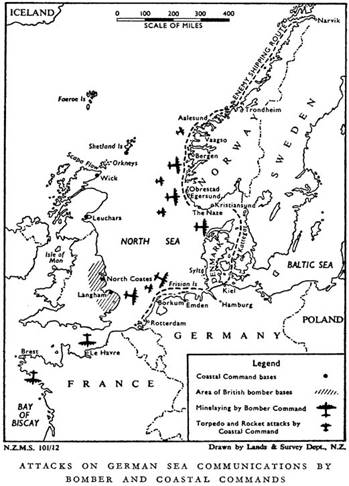
4th Op. 8th Apr ‘43 –Aircraft OJ-G, HK701. Took off at 21.29, landed at RAF Lakenheath at 03.19 Target – West Coast France (Mining)
Crew Report: Believed in mouth of Gironde between Meschera and Leverden. Visibility good apart from a little haze. Coast road at St. Seuren seen and Leverden passed after dropping mines. Parachutes seen to open and mines to fall in water.
War Diaries Comment: 27 Aircraft detailed to carry out mine laying off the Biscay Ports. 1 Wellington lost.
5th Op. 10th Apr ‘43 –Aircraft OJ-H, BF477. Took off at 00.13, landed at RAF Lakenheath at 06.19 - Target – Frankfurt.
Crew report: 10/10ths Cloud tops 4000ft. DR (Dead Reckoning) run from warning markers. No Tis or flares seen over target until after bombing. Target was not in sight but estimated to have fallen about ½ mile east of where the marker flares were later seen to fall. Nickels (propaganda Leaflets) dropped in target area.
War Diaries Comment: 502 Aircraft – 136 Lancasters, 144 Wellingtons, 124 Halifaxes, 98 Stirlings. 5 Lancasters, 3 Halifaxes, 5 Stirlings and 8 Wellingtons lost – 4.2 % of the force. Complete thick cloud cover in the target area again led to a failure. The bombing photos of every aircraft showed nothing but thick cloud and Bomber Command had no idea where the bombs had fallen. Frankfurt reported only a few in the suburbs of the city, south of the River Main.
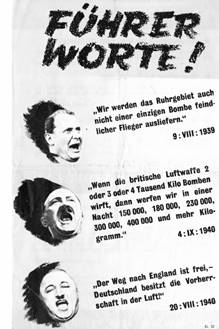 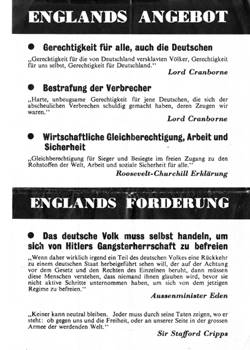
Typical ‘Nickel’ leaflets.
6th Op. 14th Apr ‘43 –Aircraft OJ-H, BF477. Took off at 21.49, landed at RAF Lakenheath at 04.23 - Target – Stuttgart.
Crew report: Timed run to target form Yellow flares. River seen. Green markers seen in bomb sight. Many fires seen – very concentrated. Large buildings seen ablaze. Flak ( Anti-aircraft fire) at Stuttgart 01.05 hrs. 1000ft. Large hole in port main plane. One in starboard main plane 3” wide and 8” long. Very successful raid. Built up area seen after bombs gone and PFF (Pathfinder Force) may have been short of AP (Aiming Point).
War Diaries Comment: 462 Aircraft – 146 Wellingtons, 98 Lancasters, 135 Halifaxes, 83 Stirlings. 3 Lancasters, 4Halifaxes, 8 Stirlings and 8 Wellingtons lost – 5.6 % of the force.

Stuttgart after the raid.
The Pathfinders claimed to have marked the centre of this normally difficult target accurately, but the main bombing area developed to the north-east, along the line of approach of the bombing force. This was a phenomena known as ‘creepback’ . On this night it caused the bombing to fall in the suburb of Bad Canstatt, which was of an Industrial nature. Some useful damage was done, particularly in the large railway-repair workshops situated there. The neighboring districts of Munster and Muhlhausen were also hit and the majority of the 393 buildings destroyed and 942 severely damaged were in these areas. Also 200+ civilian casualties were here. Only a few bombs fell in the centre of Stuttgart but the old church was destroyed. In the District of Gaisburg, 1 bomb scored a direct hit on an air raid shelter packed with French and Russian prisoners of war. 257 French and 143 Russians were killed. The total death toll from this raid was 619, a new record.
7th Op. 16th Apr ‘43 –Aircraft OJ-H, BF477. Took off at 21.55, landed at RAF Lakenheath at 23.27 - Target – Mannheim.
Crew report: 1x200, 2x100, 270x4, 24x30 (bombs) dropped (safe) on Rushforth range at 23.05 hrs. Oil pressure stbd inner (engine) dropping to 70lbs at 2200 revs and flucuating between 55 and 60 at 200 revs. (Operation abandoned)
War Diaries Comment: 271 Aircraft – 159 Wellingtons, 17 Halifaxes, 95 Stirlings. 2 Halifaxes, 7 Stirlings and 9 Wellingtons lost – 6.6 % of the force. The Pathfinders marked this target accurately and an effective attack followed. 130 Buildings were destroyed and nearly 3000 damaged. Production was stopped or reduced at 41 Industrial premises. 130 people were killed, 269 injured and 6, 954 bombed out of their homes.
8th Op. 20th Apr ‘43 –Aircraft OJ-H, BF477. Took off at 22.18, landed at RAF Lakenheath at 05.52 - Target – Rostock (Heinkel Aircraft Factory).
Crew report: Visibility clear, fairly good. Factory seen through thick smoke haze. Timed run. Buildings believed on S side of target in bomb site. Incendiaries burning both sides of river, but more on the West. Buildings to North of target well alight. Wireless Operator’s clock shot (away) Rudder trimming cable shot away. Rudder main control partially severed. Hole in roof, near fin, all from Flack.
War Diaries Comment: (Two 149 aircraft lost from seven sent) 86 Stirlings were dispatched to attack the Heinkel factory near Rostock, but a smoke screen concealed the target and bombing was scattered. 8 Stirlings lost.
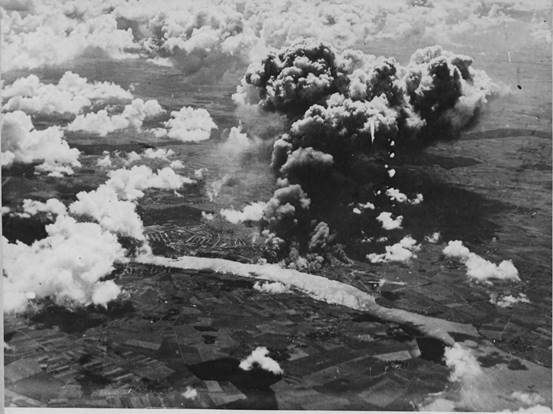
Rostock after a raid.
9th Op. 6th May ‘43 –Aircraft OJ-H, EF335. Took off at 22.47, landed at RAF Lakenheath at 02.20 - Target – Dortmund.
Crew report: Aircraft returned early as unable to maintain height. Bombed estimated position of A/D (Air Defenses) Texel.
War Diaries Comment: N/A.
10th Op. 23rd May ‘43 –Aircraft OJ-B, BF530. Took off at 22.25, landed at RAF Lakenheath at 03.12 - Target – Dortmund.
Crew report: Hazy Red T.I. at time of bombing. Bombs South and slightly East of Red and Green T.I.s. Two packages ‘Nickel’ dropped. Bomb sight U/S (Unserviceable) Green Tis dispersed and fires very scattered. Incendiaries burning on ground.
War Diaries Comment: 826 Aircraft – 343 Lancasters, 199 Halifaxes, 151 Wellingtons, 120 Stirlings and 13 mosquitoes. 18 Halifaxes, 8 Lancasters, 6 Stirlings and 6 Wellingtons lost. Many Industrial premises were hit, particularly the large Hoesch steelworks, which ceased production. 599 people were killed, 1,275 injured and the bodies of 25 people were never found.
11th Op. 25rd May ‘43 –Aircraft OJ-G, EH879. Took off at 23.38, landed at RAF Lakenheath at 04.20 - Target – Dusseldorf.
Crew report: 8-10/10ths cloud through stratus. Tops of 5/6000ft. Two lots of Yellow Tis in same spot. Red TI went down at 01.31, second at 01.35. Green TIs seen in Bombsight. Nothing much but some scattered incendiaries burning. Std engine hit by HFF (Friendly Fire) also front turret, undercarriage and several other places.
Flt Sgt Cozens (DFM) and F/O Redman (DFC) gained ‘immediate’ awards during this Operation to Dusseldorf in May '43, Gazetted 15 June '43.
The Citation reads:
“One night, in May 1943. Flying Officer Redman and Flight Sergeant Cozens were Navigator and Pilot respectively of an aircraft detailed to attack Dusseldorf. Whilst over the target area, the bomber was hit by falling incendiary bombs. The Navigator’s cabin was wrecked, the front turret was rendered unserviceable, while an oil tank was pierced and much equipment was damaged. The aircraft went out of control and lost considerable height before Flight Sergeant Cozens succeeded in regaining control. Some moveable equipment was jettisoned and a little height was gained as course was set for home. Displaying great skill, Flight Sergeant Cozens flew the damaged aircraft to this country and accomplished a safe landing in the face of many difficulties.
Throughout the return flight, Flying Officer Redman gave his Pilot valuable assistance, plotting an accurate course in spite of extremely adverse circumstances. These members of aircraft crew displayed skill and courage of a high order.”
************
All of the crew, including Flt Sgt Wiggins had a lucky escape from a very bad incident. Their skill and teamwork brought them through.
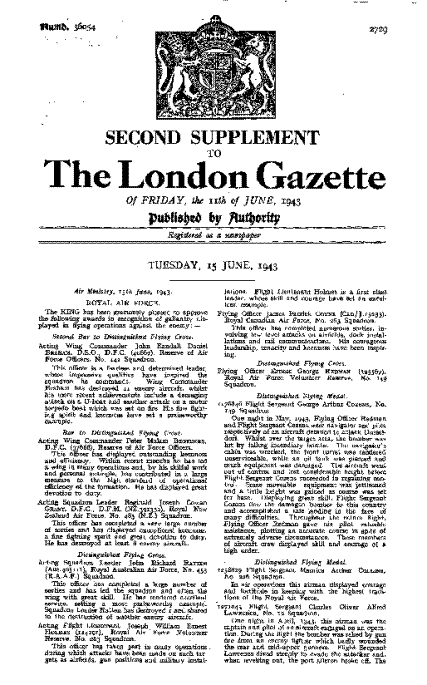
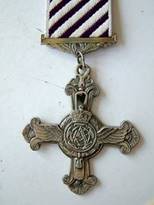 
Distinguished Flying Cross Distinguished Flying Medal
(Note: The DFC was only awarded to Commissioned Officers, the DFM to NCOs.)
12th Op. 29th May ‘43 –Aircraft OJ-B, BF530. Took off at 23.00, landed at RAF Lakenheath at 23.23. - Target – Wupertal.
This was Flight Sergeant Wiggins’s last trip with this crew.
Crew report: Aircraft returned early after Port Outer engine failed after take off. Bomb load jettisoned on Lakenheath Range.
War Diaries Comment: 719 Aircraft – 292 Lancasters, 185 Halifaxes, 118 Stirlings, 113 Wellingtons and 11 Mosquitoes. 10 Halifaxes, 8 Stirlings, 8 Wellingtons and 7 Lancasters lost. 4.6% of the force. The attack was aimed at the Barmen half of Wuppertal and was a major success in the Battle of the Ruhr. Both PFF and mainstream bombing was particularly accurate and a large fire area developed in the narrow streets of the old centre of town. Approximately 1000 acres of Barmen’s built up area (80%) was destroyed by the first ‘Firestorm’. Approximately 3,400 people were killed.
***************

The crew’s last six Operations were done without Flt Sgt Wiggins, as he was taken ill with the measles. In that time and as a mature man, measles was not a nice condition and obviously that took him off flying for some time.
The crew did their further trips with a stand-in Air Bomber (Flying Officer JJ Needham) to Dusseldorf (twice), Le Creusot, Krefeld, Mulheim and Cologne – their last trip.
The aircraft the rest of the crew flew their last Operation in was a Short’s Stirling III built by Short and Harland in Belfast under contract number 774677/38. 65 Stirlings were lost in the month of July ’43 alone.
B-Beer had arrived new to 149 Sqn on the 5th May 1943, serial number BF530 and coded OJ-B. It took off from RAF Lakenheath bound for Cologne at 23.27 on the 3rd of July 1943 and failed to return. It had survived just less than two months.
The crew for this trip were:
Flt Sgt G A Cozens DFM Pilot KIA
Sgt R F Hathaway 2nd Pilot KIA
Sgt P Hodgkinson Flt Eng KIA
F/O E G Redman DFC Navigator KIA
F/O J J Needham RCAF Bomb Aimer POW
F/O L W Curtis M.u.g. KIA
Sgt W J Williams Rear Gunner KIA
Flt Sgt R A Hodge RNZAF W/Op POW- Evaded. (Through the Comete Line escape route).
Flight Sergeant Hodge managed to evade and make his way back to the UK. His “Comete” escape number was 137 and he passed over the Pyrenees on his way to safety on 22nd September 1943. His debrief file is held on record by the National Archives (Kew) as WO 208/3315/1453.
Flying Officer Needham was caught and became POW Number 1784 at Camp L3, more commonly know as Stalag Luft Three. He was released when the camp was liberated in 1945.
The reprint below is from the 149 Sqn Operational Record Book for 1943, and records the crew’s aircraft as, “Failed to Return”. (Entry No 2). This would have been Flt Sgt Wiggins’ fate if he had not been taken ill with the measles.
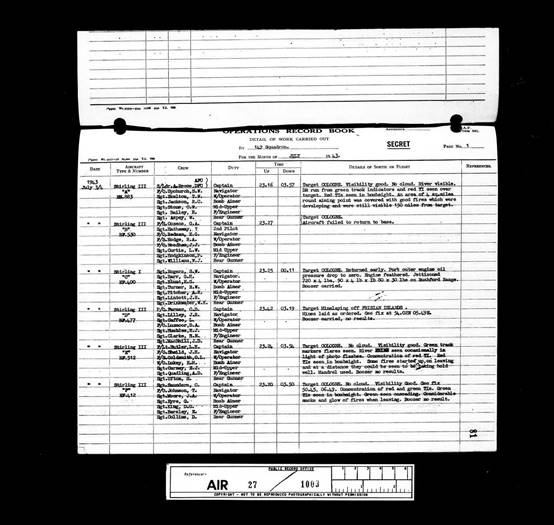
On the outbound trip the aircraft was intercepted at 14, 000ft by Oblt Heinz-wolfgang Schnaufer of II Staffel, /NJG4 and attacked. The aircraft fell and crashed at 00.58hrs, at Geetbetz (Brabant), 15 Km NE of Tienen, Belgium. Those who died are buried in Heverlee War Cemetery (below).
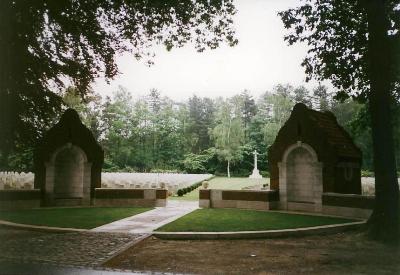
Heinz-Wolfgang Schnaufer
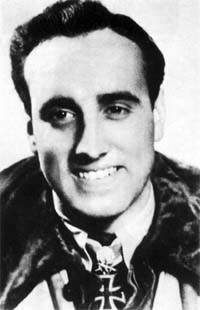
Heinz-Wolfgang Schnaufer was known as the "Spook of St. Trond" by the British.
Germany's top night fighter ace was born on the 16 February 1922 at Stuttgart and entered the Luftwaffe as a trainee officer-pilot on 15 November 1939. Following basic military training he underwent flying training at Flugzeugführerschule A/B 3 at Guben. On 1 April 1941, Schnaufer was promoted to the rank of Leutnant. There followed eight weeks at Blindflugschule at Schwäbisch Hall and 10 weeks at the Zerstörer-Schule at Wunstorf. Finally, Schnaufer was posted to the Nachtjagdschule 1, based at Schleissheim to learn the rudiments of the night-fighting art. In early November 1941, Schnaufer was posted to II./NJG 1, based at Stade near Hamburg. Leutnant Schnaufer was assigned to 5./NJG 1. On 15 January 1942, II./NJG 1 transferred to Saint-Trond in Belgium. His first victory was claimed on the night of 1/2 June 1942, when he shot down a RAF Halifax four-engine bomber near Louvain in Belgium. However, while attacking a second enemy aircraft, his aircraft was hit by return fire and he was wounded in the left leg.
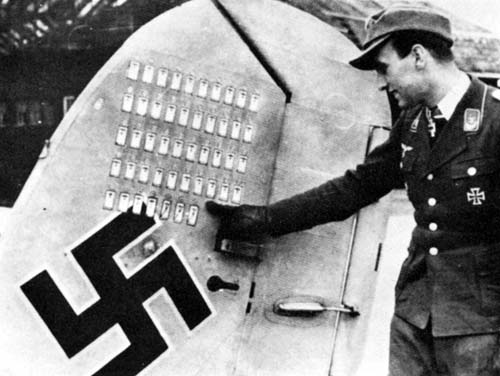
Oblt. Heinz-W. Schnaufer Staffelkapitän of 12./NJG 1 is showing his 47th victory bar on the rudder of his Bf 110 G, at St. Trond in February 1944
.
Schnaufer managed to successfully land his damaged aircraft at Saint-Trond. He was later admitted to hospital and did not return to his unit until 25 June. By the end of the year, his victory total stood at seven, including three victories recorded on the night of 31 July/1 August. Schnaufer was promoted to the rank of Oberleutnant in July 1943, when his victory total stood at 17.
Schnaufer's greatest one-off success came on 21 February 1945, when he shot down nine RAF four-engine bombers in the course of one day: two in the early hours of the morning (108-109) and a further seven, in 19 minutes, in the evening (110-116). Post-war research suggests that, in fact, his total that day was 10, one claim not having been acknowledged. On 7 March, he shot down three RAF four-engine bombers (119-121) to record his last victories of the war.
Heinz-Wolfgang Schnaufer was the top-scoring NachtJaeger of World War 2. He was credited with 121 victories recorded in 164 combat missions. His victory total included 114 four-engine bombers. . He died in hospital on 15 July 1950, two days after a car accident.
Awards : Ehrenpokal (26 July 1943)
Deutsches Kreuz in Gold (16 August 1943)
Ritterkreuz (31 December 1943)
Eichenlaub (24 June 1944)
Schwertern (30 July 1944)
Brillanten (16 October 1944)
Units : NJG 1, NJG 4
Return to Index
|
 Stirling Pilott
Stirling Pilott 
 Stirling Pilott
Stirling Pilott 